Research Methods Reflective Report - Assignment 2: Business Analysis
VerifiedAdded on 2023/06/10
|7
|1269
|164
Report
AI Summary
This report is a reflective analysis of research methods, focusing on the Gibbs reflective cycle and quantitative data analysis. The report examines the process of researching the unemployment rate in the UK, differentiating between male and female employees. It includes an introduction to the research topic, objectives, research questions, literature review, methodology, findings, and conclusions, with data presented in tables and graphs. The report discusses the student's feelings during the research, positive and negative experiences, alternative situations, and potential improvements. It highlights the acquisition of skills in quantitative analysis and literature review, reflecting on the challenges faced and the solutions implemented. The research utilizes positivism philosophy, a deductive approach, quantitative analysis, survey research strategy, and cross-sectional time horizon. The report concludes with suggestions for future research, such as incorporating interviews for more in-depth data collection. References to relevant books and journals are also provided.

Assignment 2 Research
Methods Reflective
Report
Methods Reflective
Report
Paraphrase This Document
Need a fresh take? Get an instant paraphrase of this document with our AI Paraphraser
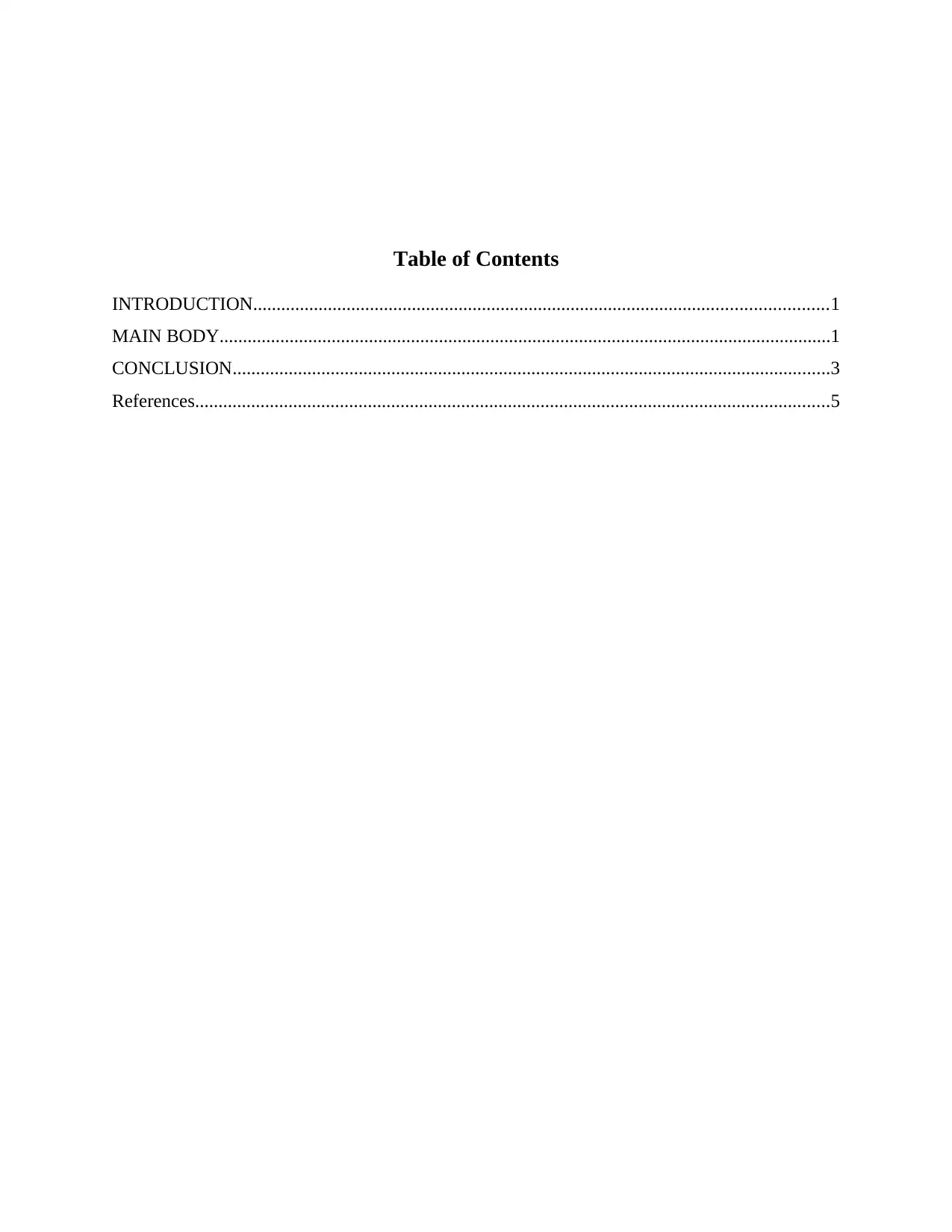
Table of Contents
INTRODUCTION...........................................................................................................................1
MAIN BODY...................................................................................................................................1
CONCLUSION................................................................................................................................3
References........................................................................................................................................5
INTRODUCTION...........................................................................................................................1
MAIN BODY...................................................................................................................................1
CONCLUSION................................................................................................................................3
References........................................................................................................................................5
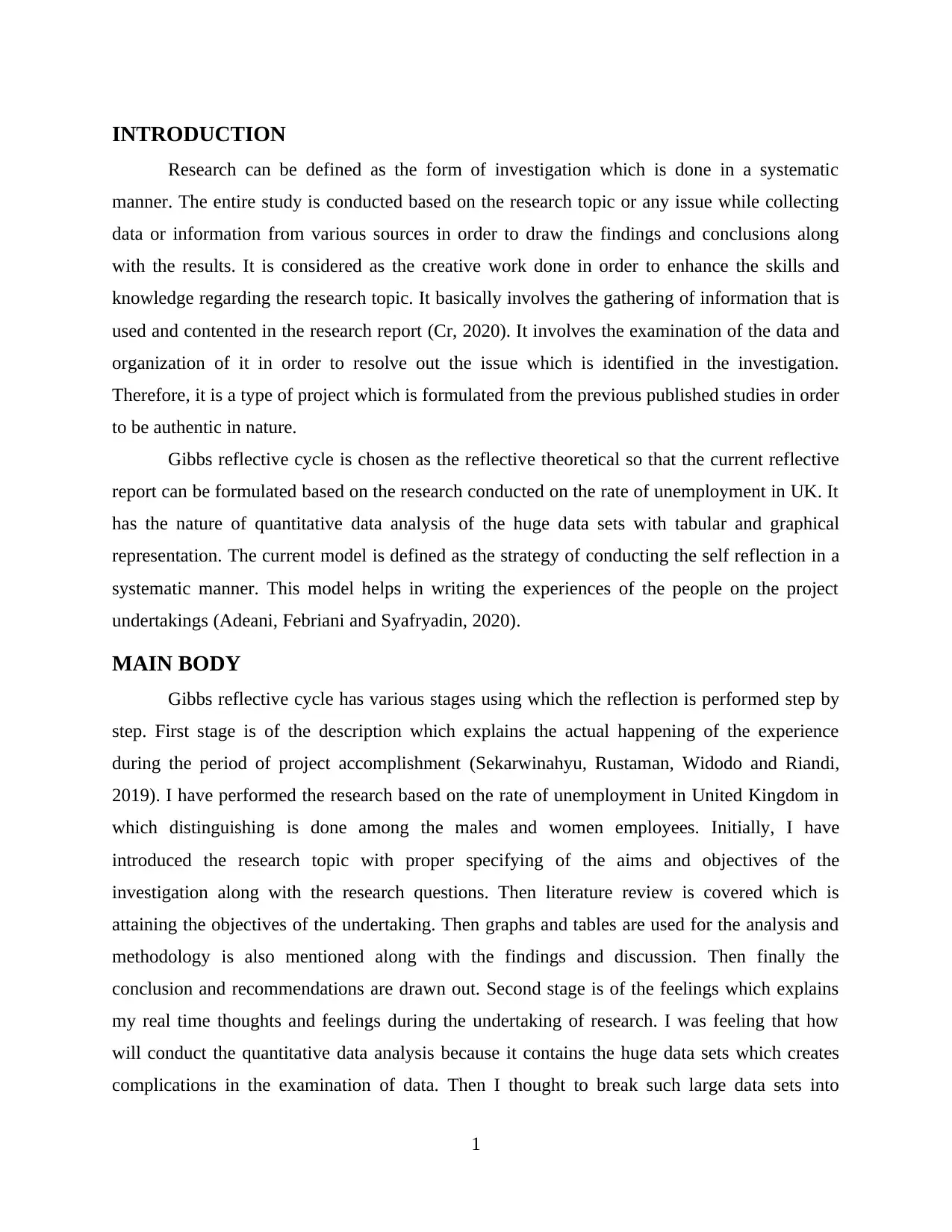
INTRODUCTION
Research can be defined as the form of investigation which is done in a systematic
manner. The entire study is conducted based on the research topic or any issue while collecting
data or information from various sources in order to draw the findings and conclusions along
with the results. It is considered as the creative work done in order to enhance the skills and
knowledge regarding the research topic. It basically involves the gathering of information that is
used and contented in the research report (Cr, 2020). It involves the examination of the data and
organization of it in order to resolve out the issue which is identified in the investigation.
Therefore, it is a type of project which is formulated from the previous published studies in order
to be authentic in nature.
Gibbs reflective cycle is chosen as the reflective theoretical so that the current reflective
report can be formulated based on the research conducted on the rate of unemployment in UK. It
has the nature of quantitative data analysis of the huge data sets with tabular and graphical
representation. The current model is defined as the strategy of conducting the self reflection in a
systematic manner. This model helps in writing the experiences of the people on the project
undertakings (Adeani, Febriani and Syafryadin, 2020).
MAIN BODY
Gibbs reflective cycle has various stages using which the reflection is performed step by
step. First stage is of the description which explains the actual happening of the experience
during the period of project accomplishment (Sekarwinahyu, Rustaman, Widodo and Riandi,
2019). I have performed the research based on the rate of unemployment in United Kingdom in
which distinguishing is done among the males and women employees. Initially, I have
introduced the research topic with proper specifying of the aims and objectives of the
investigation along with the research questions. Then literature review is covered which is
attaining the objectives of the undertaking. Then graphs and tables are used for the analysis and
methodology is also mentioned along with the findings and discussion. Then finally the
conclusion and recommendations are drawn out. Second stage is of the feelings which explains
my real time thoughts and feelings during the undertaking of research. I was feeling that how
will conduct the quantitative data analysis because it contains the huge data sets which creates
complications in the examination of data. Then I thought to break such large data sets into
1
Research can be defined as the form of investigation which is done in a systematic
manner. The entire study is conducted based on the research topic or any issue while collecting
data or information from various sources in order to draw the findings and conclusions along
with the results. It is considered as the creative work done in order to enhance the skills and
knowledge regarding the research topic. It basically involves the gathering of information that is
used and contented in the research report (Cr, 2020). It involves the examination of the data and
organization of it in order to resolve out the issue which is identified in the investigation.
Therefore, it is a type of project which is formulated from the previous published studies in order
to be authentic in nature.
Gibbs reflective cycle is chosen as the reflective theoretical so that the current reflective
report can be formulated based on the research conducted on the rate of unemployment in UK. It
has the nature of quantitative data analysis of the huge data sets with tabular and graphical
representation. The current model is defined as the strategy of conducting the self reflection in a
systematic manner. This model helps in writing the experiences of the people on the project
undertakings (Adeani, Febriani and Syafryadin, 2020).
MAIN BODY
Gibbs reflective cycle has various stages using which the reflection is performed step by
step. First stage is of the description which explains the actual happening of the experience
during the period of project accomplishment (Sekarwinahyu, Rustaman, Widodo and Riandi,
2019). I have performed the research based on the rate of unemployment in United Kingdom in
which distinguishing is done among the males and women employees. Initially, I have
introduced the research topic with proper specifying of the aims and objectives of the
investigation along with the research questions. Then literature review is covered which is
attaining the objectives of the undertaking. Then graphs and tables are used for the analysis and
methodology is also mentioned along with the findings and discussion. Then finally the
conclusion and recommendations are drawn out. Second stage is of the feelings which explains
my real time thoughts and feelings during the undertaking of research. I was feeling that how
will conduct the quantitative data analysis because it contains the huge data sets which creates
complications in the examination of data. Then I thought to break such large data sets into
1
⊘ This is a preview!⊘
Do you want full access?
Subscribe today to unlock all pages.

Trusted by 1+ million students worldwide

smaller sets, this can help in the detailed quantitative analysis. Quantitative type of analysis is
done in the form of numeric data so that results drawn can be in the form of facts and figures.
Third stage is of the evaluation which explains the positive experience and the negative
experience of the project undertaking (Pieper, Roelle, vom Hofe and Berthold, 2021). Talking
about the positive experience, I have acquired the knowledge about how to conduct the
quantitative analysis and how can I study the huge data sets in an appropriate way. Talking about
the negative experience, I was facing issue in researching the authentic content for the literature
review. The reason being is that it involves the theory which creates problems in searching the
sources of well known authors in an authentic manner either from the books or journals. Fourth
stage is of the analysis which explains that how can I content any alternative situation. The
current research is undertaken on the rate of unemployment in UK. Other situations can be the
other issues related to the changing trends of consumer buying behaviour which highly affects
the business stability in the market place. This is because it will then adopt the research method
of qualitative which further reads the huge data sets in a potential manner. Fifth stage is of the
conclusion which explains that what other solutions can be drawn out. I would have more
emphasised on the literature review part so that the information written can be more authentic
written by well known authors according the findings and results drawn after the quantitative
analysis. Sixth stage is of the action plan which explains that if the issue raises again then what
can be the other alternate solution for it (Othman, Effendi, Kamaruddin and Zainal, 2020). I will
try to use the other alternate method of research so that I can get the in depth data and
information such as conducting of the interview so that I can get the personalised onions from
the respondents. This can help in addressing the issue in a more accurate manner because its uses
the face to face conversations which helps in the detailed quantitative analysis.
2
done in the form of numeric data so that results drawn can be in the form of facts and figures.
Third stage is of the evaluation which explains the positive experience and the negative
experience of the project undertaking (Pieper, Roelle, vom Hofe and Berthold, 2021). Talking
about the positive experience, I have acquired the knowledge about how to conduct the
quantitative analysis and how can I study the huge data sets in an appropriate way. Talking about
the negative experience, I was facing issue in researching the authentic content for the literature
review. The reason being is that it involves the theory which creates problems in searching the
sources of well known authors in an authentic manner either from the books or journals. Fourth
stage is of the analysis which explains that how can I content any alternative situation. The
current research is undertaken on the rate of unemployment in UK. Other situations can be the
other issues related to the changing trends of consumer buying behaviour which highly affects
the business stability in the market place. This is because it will then adopt the research method
of qualitative which further reads the huge data sets in a potential manner. Fifth stage is of the
conclusion which explains that what other solutions can be drawn out. I would have more
emphasised on the literature review part so that the information written can be more authentic
written by well known authors according the findings and results drawn after the quantitative
analysis. Sixth stage is of the action plan which explains that if the issue raises again then what
can be the other alternate solution for it (Othman, Effendi, Kamaruddin and Zainal, 2020). I will
try to use the other alternate method of research so that I can get the in depth data and
information such as conducting of the interview so that I can get the personalised onions from
the respondents. This can help in addressing the issue in a more accurate manner because its uses
the face to face conversations which helps in the detailed quantitative analysis.
2
Paraphrase This Document
Need a fresh take? Get an instant paraphrase of this document with our AI Paraphraser
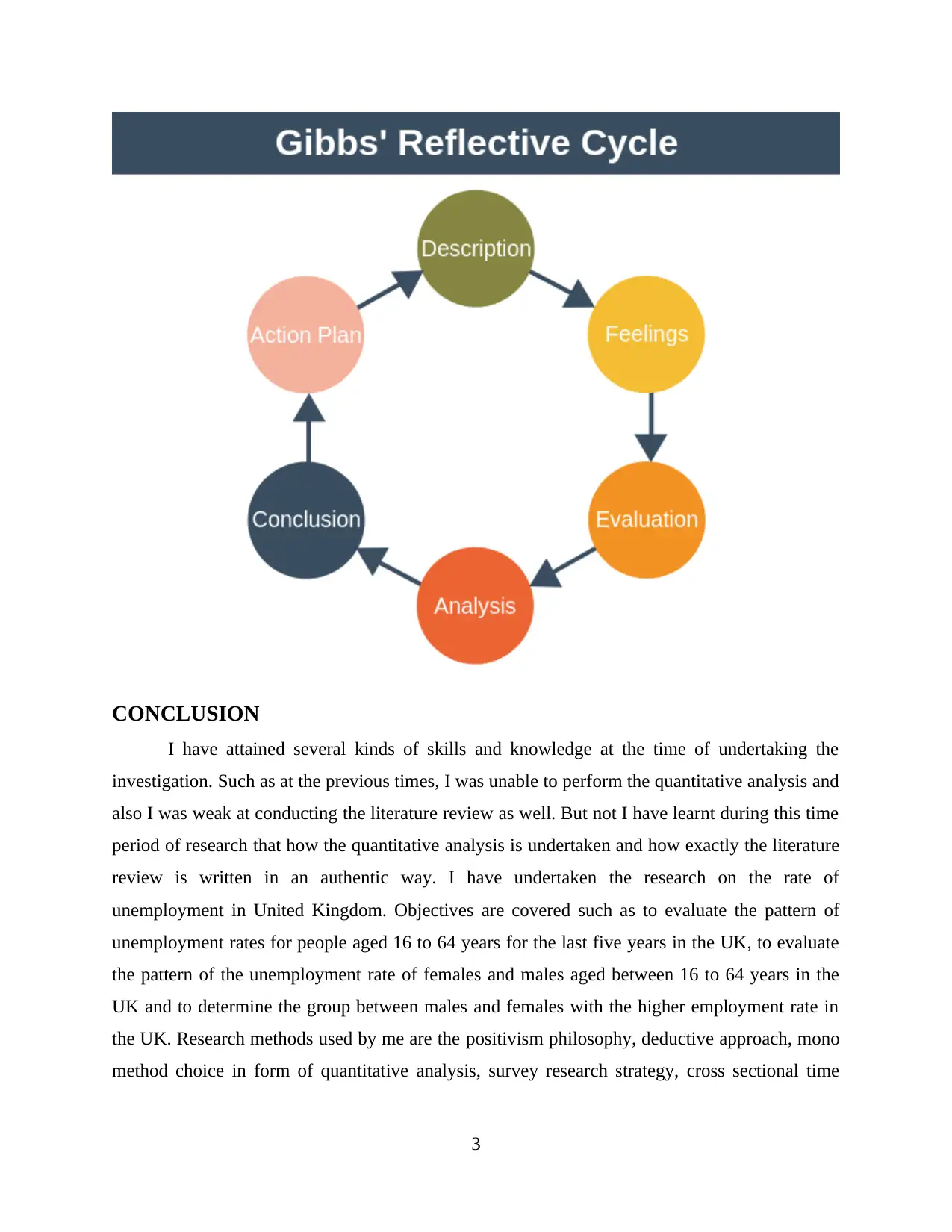
CONCLUSION
I have attained several kinds of skills and knowledge at the time of undertaking the
investigation. Such as at the previous times, I was unable to perform the quantitative analysis and
also I was weak at conducting the literature review as well. But not I have learnt during this time
period of research that how the quantitative analysis is undertaken and how exactly the literature
review is written in an authentic way. I have undertaken the research on the rate of
unemployment in United Kingdom. Objectives are covered such as to evaluate the pattern of
unemployment rates for people aged 16 to 64 years for the last five years in the UK, to evaluate
the pattern of the unemployment rate of females and males aged between 16 to 64 years in the
UK and to determine the group between males and females with the higher employment rate in
the UK. Research methods used by me are the positivism philosophy, deductive approach, mono
method choice in form of quantitative analysis, survey research strategy, cross sectional time
3
I have attained several kinds of skills and knowledge at the time of undertaking the
investigation. Such as at the previous times, I was unable to perform the quantitative analysis and
also I was weak at conducting the literature review as well. But not I have learnt during this time
period of research that how the quantitative analysis is undertaken and how exactly the literature
review is written in an authentic way. I have undertaken the research on the rate of
unemployment in United Kingdom. Objectives are covered such as to evaluate the pattern of
unemployment rates for people aged 16 to 64 years for the last five years in the UK, to evaluate
the pattern of the unemployment rate of females and males aged between 16 to 64 years in the
UK and to determine the group between males and females with the higher employment rate in
the UK. Research methods used by me are the positivism philosophy, deductive approach, mono
method choice in form of quantitative analysis, survey research strategy, cross sectional time
3
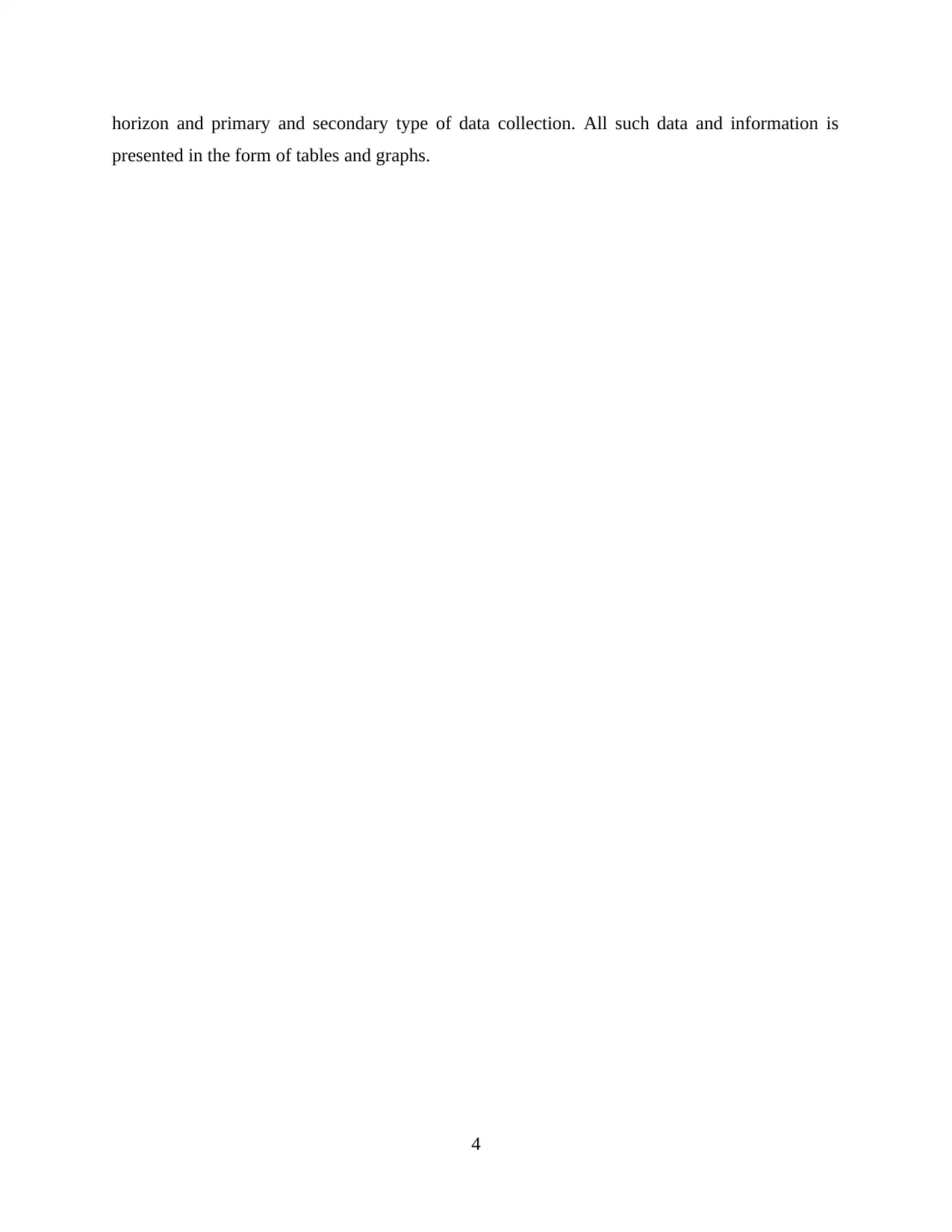
horizon and primary and secondary type of data collection. All such data and information is
presented in the form of tables and graphs.
4
presented in the form of tables and graphs.
4
⊘ This is a preview!⊘
Do you want full access?
Subscribe today to unlock all pages.

Trusted by 1+ million students worldwide
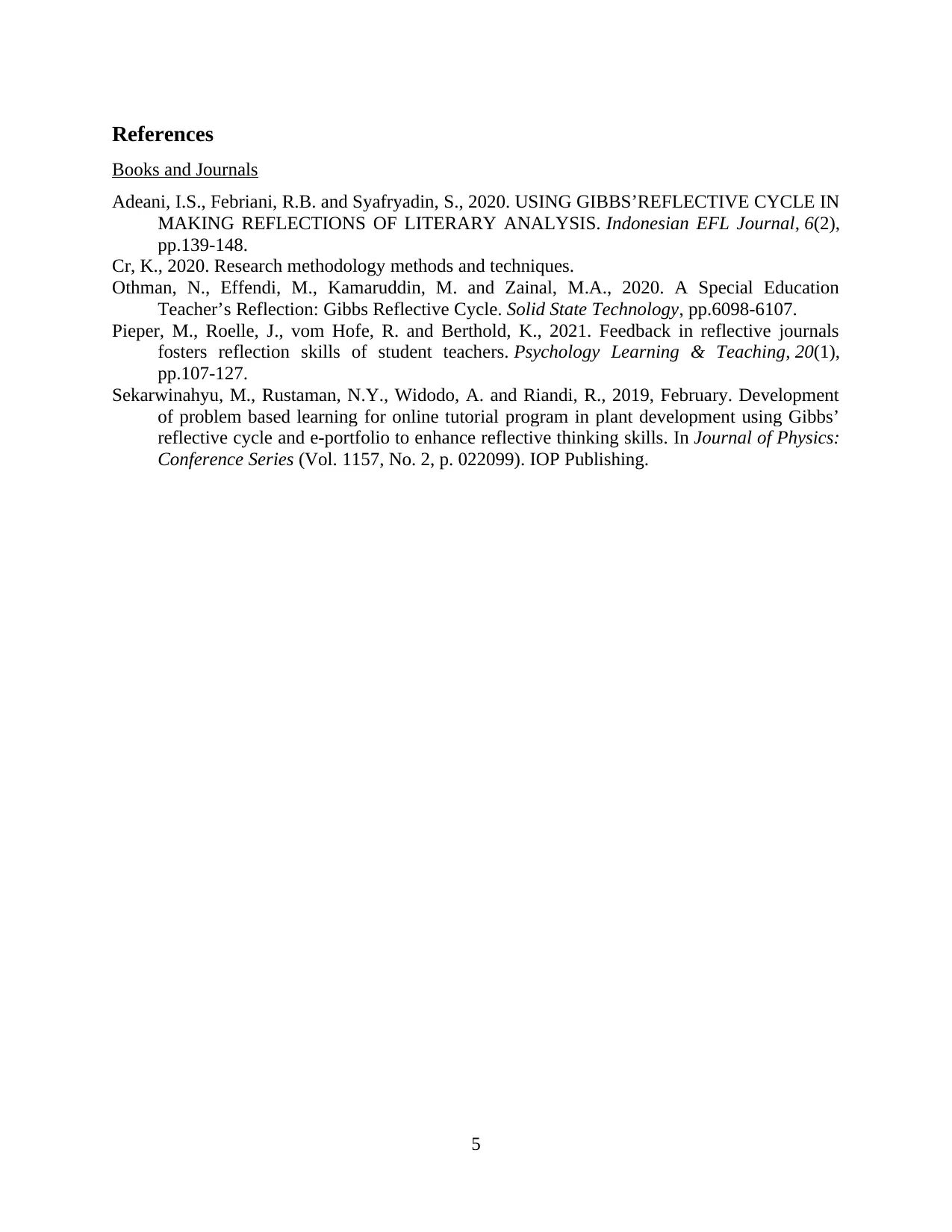
References
Books and Journals
Adeani, I.S., Febriani, R.B. and Syafryadin, S., 2020. USING GIBBS’REFLECTIVE CYCLE IN
MAKING REFLECTIONS OF LITERARY ANALYSIS. Indonesian EFL Journal, 6(2),
pp.139-148.
Cr, K., 2020. Research methodology methods and techniques.
Othman, N., Effendi, M., Kamaruddin, M. and Zainal, M.A., 2020. A Special Education
Teacher’s Reflection: Gibbs Reflective Cycle. Solid State Technology, pp.6098-6107.
Pieper, M., Roelle, J., vom Hofe, R. and Berthold, K., 2021. Feedback in reflective journals
fosters reflection skills of student teachers. Psychology Learning & Teaching, 20(1),
pp.107-127.
Sekarwinahyu, M., Rustaman, N.Y., Widodo, A. and Riandi, R., 2019, February. Development
of problem based learning for online tutorial program in plant development using Gibbs’
reflective cycle and e-portfolio to enhance reflective thinking skills. In Journal of Physics:
Conference Series (Vol. 1157, No. 2, p. 022099). IOP Publishing.
5
Books and Journals
Adeani, I.S., Febriani, R.B. and Syafryadin, S., 2020. USING GIBBS’REFLECTIVE CYCLE IN
MAKING REFLECTIONS OF LITERARY ANALYSIS. Indonesian EFL Journal, 6(2),
pp.139-148.
Cr, K., 2020. Research methodology methods and techniques.
Othman, N., Effendi, M., Kamaruddin, M. and Zainal, M.A., 2020. A Special Education
Teacher’s Reflection: Gibbs Reflective Cycle. Solid State Technology, pp.6098-6107.
Pieper, M., Roelle, J., vom Hofe, R. and Berthold, K., 2021. Feedback in reflective journals
fosters reflection skills of student teachers. Psychology Learning & Teaching, 20(1),
pp.107-127.
Sekarwinahyu, M., Rustaman, N.Y., Widodo, A. and Riandi, R., 2019, February. Development
of problem based learning for online tutorial program in plant development using Gibbs’
reflective cycle and e-portfolio to enhance reflective thinking skills. In Journal of Physics:
Conference Series (Vol. 1157, No. 2, p. 022099). IOP Publishing.
5
1 out of 7
Related Documents
Your All-in-One AI-Powered Toolkit for Academic Success.
+13062052269
info@desklib.com
Available 24*7 on WhatsApp / Email
![[object Object]](/_next/static/media/star-bottom.7253800d.svg)
Unlock your academic potential
Copyright © 2020–2025 A2Z Services. All Rights Reserved. Developed and managed by ZUCOL.


